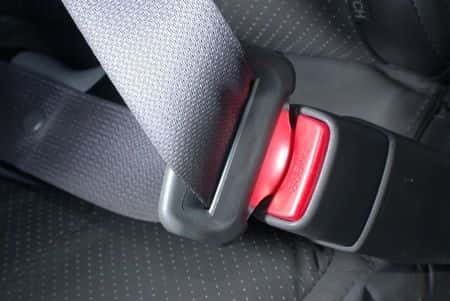Defective Seat Belt Unlatched During Automotive Rollover Accident
Updated on
This case arises out of a rollover car accident involving an SUV that struck a utility pole. Plaintiff, who was a front-seat passenger in the vehicle, was ejected. She suffered a traumatic brain injury. She alleges she was properly wearing her seat belt but the belt false latched, releasing during the crash. She alleges defects in the design and manufacture of the passenger restraint system; the rear panel and glass; the vehicle’s suspension; and the interior components and padding. She filed suit against the vehicle manufacturer and the maker of the seat-belt system.
Question(s) For Expert Witness
1. Was the plaintiff belted at the time of the crash?
2. What evidence supports this?
3. Was the latch defective?
4. Were there alternative designs?
Expert Witness Response
 None of the materials provided to me, including the defense expert reports, are inconsistent with the hypothesis plaintiff was lap/shoulder-belted at the start of the accident sequence, given that this buckle contains numerous design defects, which could lead to unlatching, as described in my report. None of the GBL buckles that I have measured match the design drawings, consistent with a high potential for failure. Further, the driver testified under oath that plaintiff was safety belted.
None of the materials provided to me, including the defense expert reports, are inconsistent with the hypothesis plaintiff was lap/shoulder-belted at the start of the accident sequence, given that this buckle contains numerous design defects, which could lead to unlatching, as described in my report. None of the GBL buckles that I have measured match the design drawings, consistent with a high potential for failure. Further, the driver testified under oath that plaintiff was safety belted.
 I inspected the accident vehicle, the seat belts, photographs of the vehicle and the accident scene, depositions and statements of other experts and witnesses, medical records, police accident report, and other such physical and testimonial evidence. My inspection also showed significant witness marks on the safety belt hardware, including webbing imprints on the B pillar interior trim and bending of the pretensioner cable guide, which are consistent with the hypothesis that plaintiff was belted. With regard to the safety belt as stated in my report, I found the following:
I inspected the accident vehicle, the seat belts, photographs of the vehicle and the accident scene, depositions and statements of other experts and witnesses, medical records, police accident report, and other such physical and testimonial evidence. My inspection also showed significant witness marks on the safety belt hardware, including webbing imprints on the B pillar interior trim and bending of the pretensioner cable guide, which are consistent with the hypothesis that plaintiff was belted. With regard to the safety belt as stated in my report, I found the following:
 The physical evidence on the belt supports the conclusion that it was restraining plaintiff prior to the collision. This evidence is independent of any testimony, and, standing alone, demonstrates conclusively that plaintiff was belted at the beginning of the accident sequence, prior to the vehicle striking a utility pole and yawing to rest as it tipped onto its driver's side.
The physical evidence on the belt supports the conclusion that it was restraining plaintiff prior to the collision. This evidence is independent of any testimony, and, standing alone, demonstrates conclusively that plaintiff was belted at the beginning of the accident sequence, prior to the vehicle striking a utility pole and yawing to rest as it tipped onto its driver's side.
 The evidence described above, when taken altogether, is most consistent with plaintiff having been lap/shoulder-belted at the beginning of the accident, and the lap/shoulder belt tongue becoming separated from the buckle during the collision, I have reached the conclusion, to a reasonable degree of engineering probability, that plaintiff was wearing her seat belt when the collision sequence began.
The evidence described above, when taken altogether, is most consistent with plaintiff having been lap/shoulder-belted at the beginning of the accident, and the lap/shoulder belt tongue becoming separated from the buckle during the collision, I have reached the conclusion, to a reasonable degree of engineering probability, that plaintiff was wearing her seat belt when the collision sequence began.
 Separation of the tongue from the buckle demonstrates the existence of a defect in the restraint system, either in its manufacture or design. Accordingly, I then proceeded to perform a failure analysis to determine the cause of the separation of the tongue from the buckle in this accident. I looked at all possible causes and eliminated those that were not probable, given the facts and circumstances, physical evidence, and test data. Once I had determined the most likely cause(s), I then evaluated alternative designs or conditions, which would have precluded the type of system failure.
Separation of the tongue from the buckle demonstrates the existence of a defect in the restraint system, either in its manufacture or design. Accordingly, I then proceeded to perform a failure analysis to determine the cause of the separation of the tongue from the buckle in this accident. I looked at all possible causes and eliminated those that were not probable, given the facts and circumstances, physical evidence, and test data. Once I had determined the most likely cause(s), I then evaluated alternative designs or conditions, which would have precluded the type of system failure.
 My inspection of the accident buckle leads me to conclude in this event that an inadvertent unlatch problem did not exist in plaintiff’s buckle, since there is no physical evidence of press button contact, and the damage that exists on the buckle is not indicative of bending in the direction of push button movement required to open the buckle. However, this buckle is extremely susceptible to remaining in an incompletely latched position if the press button is depressed slightly below the cover. My analysis of the design and Key Safety documents indicate that the manufacturing defects in the buckle increase the risk of the buckle being incompletely latched.
My inspection of the accident buckle leads me to conclude in this event that an inadvertent unlatch problem did not exist in plaintiff’s buckle, since there is no physical evidence of press button contact, and the damage that exists on the buckle is not indicative of bending in the direction of push button movement required to open the buckle. However, this buckle is extremely susceptible to remaining in an incompletely latched position if the press button is depressed slightly below the cover. My analysis of the design and Key Safety documents indicate that the manufacturing defects in the buckle increase the risk of the buckle being incompletely latched.
 I concluded that inertial, impact or shock loading was a likely partial explanation for buckle failure in this case. Therefore, I investigated whether forces could be applied to the safety belt buckle in ways that might cause it to release in an accident in an unintended manner. One possible force direction to a seat belt buckle in an accident is the lateral application of force, usually to the back of a buckle, which causes the latch to move out of its engaged position, allowing the tongue to be released.
I concluded that inertial, impact or shock loading was a likely partial explanation for buckle failure in this case. Therefore, I investigated whether forces could be applied to the safety belt buckle in ways that might cause it to release in an accident in an unintended manner. One possible force direction to a seat belt buckle in an accident is the lateral application of force, usually to the back of a buckle, which causes the latch to move out of its engaged position, allowing the tongue to be released.
 I have identified alternative designs of seat belt buckles available in the marketplace at and prior to the time of manufacture of this vehicle that minimize the risks of failure due to shock loading, as identified in my reports and deposition. The design changes that have been made to the GBL buckle have reduced its susceptibility to incomplete latching.
I have identified alternative designs of seat belt buckles available in the marketplace at and prior to the time of manufacture of this vehicle that minimize the risks of failure due to shock loading, as identified in my reports and deposition. The design changes that have been made to the GBL buckle have reduced its susceptibility to incomplete latching.
About the author
Kristin Casler
Kristin Casler is a seasoned legal writer and journalist with an extensive background in litigation news coverage. For 17 years, she served as the editor for LexisNexis Mealey’s litigation news monitor, a role that positioned her at the forefront of reporting on pivotal legal developments. Her expertise includes covering cases related to the Supreme Court's expert admissibility ruling in Daubert v. Merrell Dow Pharmaceuticals Inc., a critical area in both civil and criminal litigation concerning the challenges of 'junk science' testimony.
Kristin's work primarily involves reporting on a diverse range of legal subjects, with particular emphasis on cases in asbestos litigation, insurance, personal injury, antitrust, mortgage lending, and testimony issues in conviction cases. Her contributions as a journalist have been instrumental in providing in-depth, informed analysis on the evolving landscape of these complex legal areas. Her ability to dissect and communicate intricate legal proceedings and rulings makes her a valuable resource in the legal journalism field.
Subscribe to our newsletter
Join our newsletter to stay up to date on legal news, insights and product updates from Expert Institute.
Sign up nowFind an expert witness near you
What State is your case in?
Subscribe to our newsletter
Join our newsletter to stay up to date on legal news, insights and product updates from Expert Institute.



